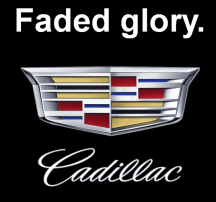
How would you position Cadillac, the auto-industry’s faded glory?
“What else can we get into?” That’s the first question new management asks itself when it takes over a company.
Johan de Hysschen, Cadillac’s new president, has been on the job just five months and has found many possibilities.
Two in particular. A small crossover SUV and an entry-level car priced below the Cadillac ATS. Both vehicles are included in a $12 billion, multi-year capital-expansion plan.
Cadillac should have studied the recent history of Hyundai.
More is not always more.
For 13 years in a row, Hyundai outperformed (or under-declined) the U.S. automotive market. And not by a small margin. Hyundai outperformed the market by a median average of 9.7 percent.
In those 13 years, Hyundai sales grew from 90,217 vehicles in 1998 to 645,691 vehicles in 2011.
But the following year that growth suddenly came to a halt. In 2012, Hyundai under-performed the overall market by 4.5 percent. In 2013, Hyundai under-performed the market by 5.0 percent. In 2014, Hyundai under-performed the market by 5.2 percent.
Why? Line extension, in my opinion.
In 2008, Hyundai introduced its Genesis model, starting at $38,000. In 2010, Hyundai introduced its Equus model, starting at $58,000. Both were considerably more expensive than Hyundai’s entry-level models, Elantra and Sonata.
Actually, the high-end Hyundais received very favorable reviews. Typical headline: 2015 Hyundai Genesis is a Home Run.
And to show off its new high-end models, the company sponsored a PGA event in Hawaii this year, the Hyundai Tournament of Champions.
Undermining its low-end perception.
As good as the high-end models are, they are not helping the Hyundai brand because they are undermining its low-end perception. But this didn’t happen overnight. It took several years for Hyundai sales to decline.
That’s typical of a perception problem, not a product problem. Perception problems can take years before they affect a brand’s sales.
But that’s not what Hyundai management thinks. Said Dave Zuchowski, Hyundai Motor America CEO: “Over the last couple years, our relative position has weakened, not as a result of actions on our part, but on the part of our competitors with very, very unusually generous programs.”
Hyundai dealers seem to disagree. Headline in Automotive News last month: Dealers to Hyundai: What’s the message?
When you sell everything under one brand name, you have no overall message.
Another brand Cadillac should have studied is Saturn.
The rise and fall of Saturn.
In 1994, just four years after its introduction, Saturn hit its high-water mark, selling 286,003 vehicles. That year, the average Saturn dealer sold more vehicles than the average of any other brand.
In 1995, J.D. Power & Associates, the auto industry’s leading research firm, ranked Saturn “No.1 in satisfying new-car buyers.”
So what did Saturn do next? Did it try to expand its market share in inexpensive entry-level vehicles? Or did it try to expand the Saturn brand into larger and more expensive vehicles, the same strategy used by Hyundai?
What would you have done next? What did every automotive expert tell Saturn it should do next?
You’re right. Expand the brand.
In 1999, Saturn introduced the L series, its larger, more-expensive vehicle. Saturn’s president at the time expected the combined S series and L series to double Saturn sales in a couple of years.
• In 2002, Saturn introduced a crossover SUV, the Vue.
• In 2005, Saturn introduced the Relay minivan.
• In 2006, The Sky roadster.
• In 2007, the Aura midsize sedan.
• In 2008, the Outlook, a larger crossover SUV.
• In 2009, Saturn ceased production.
Now here’s a fact Cadillac management should consider. In all those years, annual Saturn sales never exceeded its 1994 high-water mark when it sold only one model, the original S series.
Another brand Cadillac should have studied is Cadillac.
The Cadillac of X.
Cadillacs were once so highly thought of that the phrase “the Cadillac of X” was coined, meaning that a particular brand was better than everything else in its category.
The Cadillac of lawn movers. The Cadillac of strollers. The Cadillac of dish washers. The Cadillac of Christmas trees.
In the parking lots of high-end country clubs, Cadillac used to be the dominant brand. No more. Today, those same lots are loaded with Mercedes, BMW and Lexus vehicles.
What happened to Saturn and Hyundai also happened to Cadillac, but in the opposite direction. While Saturn and Hyundai tried to move up, Cadillac tried to move down.
In 1981, Cadillac introduced its relatively-inexpensive model, the Cimarron. Four years later, Cadillac hit its high-water mark, selling 320,017 vehicles.
Since then, it’s been mostly downhill. In 1997, Cadillac again tried selling less-expensive vehicles with the launch of the Catera. (Maybe you remember Ziggy, the Catera duck, as well as the slogan, “The Caddy that zigs.”)
Nothing has helped Cadillac close the gap with Mercedes and BMW. Last year, Cadillac sold 170,750 vehicles, down 47 percent from 1984, while the total market was up 9 percent.
Compared to Cadillac’s 47 percent decline since 1984, Mercedes is up 350 percent and BMW is up 379 percent. And both brands outsell Cadillac by a wide margin.
How do you build a brand?
You try to own a word in the mind. Mercedes-Benz, built by the company that invented the automobile, owns “prestige.” BMW owns “driving.” Volvo owns “safety.” Subaru owns “”4-wheel drive.”
So what word does Cadillac think it can own? According to Cadillac president John de Hysschen, “We want to build our reputation as a purveyor of high-performance drivers’ cars.”
So that’s it. No just “driving” machines, but “high-performance driving” machines. Lots of luck.
What word comes to your mind when somebody mentions Cadillac? The word that comes to my mind is “Escalade.”
In my opinion, Cadillac should focus on high-end SUVs. But, of course, that would mean “focusing” the Cadillac brand instead of “line extending” the Cadillac brand.
And what CEO wants to do that?
 ?>
?>